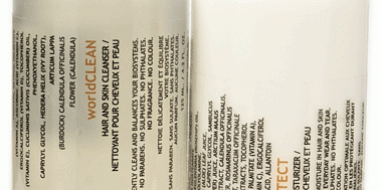The skin is your largest organ and helps provide a protective barrier between your body and the environment. This barrier is what is referred to as semi permeable. You can think of semi permeable as a piece of cheesecloth. It allows some substances to pass into the body while stopping some from getting in. Unfortunately, toxins in skincare products do pass through the barrier. This is harmful because substances that are absorbed through the skin get directly into the bloodstream and are quickly distributed throughout the body.
So now that we know what we put on skin can have an effect on our overall health the next step is trying to make safer choices with skin care products. People often feel overwhelmed when reading skincare labels and think that they have to get rid of everything all at once. If you want to replace all your products, great! But we must also keep in mind that every little change helps. If you are looking to change over to toxin free products over time that’s ok too. You will want to take out the most harmful products first.
As a general rule, the chemical based products to eliminate first are the ones that you use the most frequently and on the largest amount of your skin. Here is my guide to the ten personal care products to switch to chemical free in order of importance
1. Body Butter/Lotion
Body lotion fits the bill for being something that people put on frequently, in a lot of cases daily. It’s applied to a large surface area of the body, and is a leave on product. Leave on products present a higher risk of toxins being absorbed into the skin. This is a great product to switch out if you have a teenager who loves buying the chemical based ones with scents so strong you can smell them a mile away!
2. Facial Moisturizer
Typically it is applied twice a day and is also a leave on product. Facial moisturizer is not one people tend to forget very often, unless, maybe, you are an exhausted new mom. There are tonnes of good toxin free alternatives that contain ingredients that help increase the overall health and condition of the skin, without the risks associated with toxins.
3. Foundation
Foundation is similar to facial moisturizer in that it is applied frequently and is another leave on product. Conventional foundations contain many harmful ingredients including, but not limited to: lead, 1,3-butadience (a known carcinogen), polycyclic aromatic hydrocarbons, parabens and phthalates.
4. Lipstick/Lip Balm
Lead is frequently found in many conventional lipsticks. Lip products are concerning because inevitably some the product you put on your lip ends up getting ingested.
5. Shampoo and Body Wash
Although they are not leave on products, the combination of shampoo and body wash are in contact with a large surface area of your skin and are used frequently. Shampoos contain sodium laureth sulfate, which helps them to foam. It is commonly contaminated with ethylene oxide, a known carcinogen, with an affinity for breast tissue.
6. Hand Soap
Soap from a certain chain of stores that have been popping up in malls everywhere, are so strongly scented that it is highly likely they are high in phthalates. Phthalates help to make scents last longer. You usually will not see phthalates listed on the ingredient label as they are allowed to be lumped into the term “fragrance”. Anti-bacterial soaps are another big no-no for daily use. They contain triclosan, a known hormone disruptor. Widespread use can increase the risk of microbial resistant bacteria.
7. Perfume
Perfumes contain high levels of parabens and phthalates but you will never know what exactly is in your favourite scent as there are trade secret laws that protect perfume makers from having to disclose the specific formulas for their scents.
8. Nail Polish
That “nail polish smell” can be a sign of airborne toxic chemicals. If using conventional polishes they should be used infrequently and in a well ventilated room. A recent study from Duke University found that much higher levels of triphenyl phosphate, a suspected endocrine disruptor, in the urine of women after having their nails painted.
9. Mascara
Although worn frequently by most people, it does not have directed sustained contact with the skin. Mascara does typically contain parabens, aluminum, and propylene glycol making it one to phase out as you get your toxin free skin care regime going.
10. Eye Shadow
The skin on the eyelids in quite thin and has an abundant blood supply, however the overall amount of eye shadow applied to the eyelids is small, limiting the exposure to toxins. Eye shadow does contain talc, which is a well-established respiratory irritant.
What to look for in alternative products
When looking for toxin free alternatives, look for products that are made with real butters. Cocoa and Shea are great examples. The ingredients should have natural oils like grapeseed or avocado and be scented with essential oils (listed with Latin names). Avoid any product with parfum or fragrance listed as an ingredient. This is a way that companies can put parabens and phthalates into their products without having to put them on the label, as fragrance is considered proprietary information and its components do not have to be disclosed.
A good place to start your search for safer products is your local health/natural food store. Most of these stores have criteria that products have to comply with to be carried there. Whole Foods is one example of a national retailer that carries a wide variety of safe and effective skin care products. Another option is to browse the Environmental Working Group's Skin Deep page or app, and search your products and product alternatives for the least dangerous options.
Good luck on your journey to a healthier skin care routine, and remember every little change makes a big difference.






